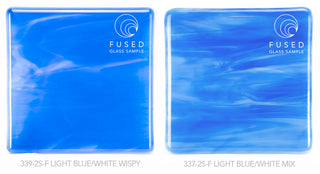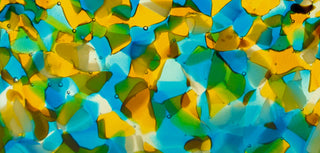
possible changes during fusing
Wha might be going on with some unexpected outcomes
While all of our products are originally created using significant amounts of heat, reheating glass to fusing temperatures will result in further changes to the glass — but not every change will be what you might expect. This section explores known glass properties that may impact your work, allowing you to better predict fusing outcomes.
Color Changes
Kiln-firing some glasses can result in a change of color from the original sheet. This can happen for a variety of reasons.
Striking Colors
Some colors — most notably hot ones like oranges and reds — tend to be more volatile than others and are prone to “striking.” Striking simply means changing color, and most often the color shifts to a darker shade than the original sheet. If color is critical in work featuring hot colors, fire a small piece of glass cut from the sheet you intend to use to determine if it will work in your project. We do not currently produce any glass intended to strike to a certain color
Also note that some solid opal colors can shift slightly becoming a little lighter or darker but tend to stay close enough to the cold sheet that it usually isn’t problematic or considered to be a true "strike" in color shift.

Amber Mixes shifting
The same colorants that make Amber/Opal mixes so beautiful in the cold sheet, can also react together when heated further — resulting in a darker or muddied appearance after fusing. This tendency can vary widely so always test the glass first before incorporating it into an important project. Also keep in mind that the reaction may be stronger the more heat that is applied; a tack fused piece may exhibit less change than one taken to a full fuse.
Pictured at left are products containing Amber and Opal that have been known to react when kiln-fired. Be sure to test these before using in important work. (Note that the products have been kept in numerical order for easier reference.)

Changes in variegation
The delicate wisps of opal in sheets of our Wispy glasses will soften and be less pronounced in a full fuse. Heavier amounts of variegation typically will not change much when fired.
Fusing Textured Sheets
Trapping air into bubbles is the most common issue that results from firing textured sheets. You can use this to your advantage and create intentional bubbles, but most often you will want to mitigate bubble formation.
Below are fused samples of our Light Green (121) in several common textures ranging from Smooth to Rough Rolled. Each was clear-capped and full fused. Note the range of bubble formation with the Smooth resulting in the fewest bubbles and Rough Rolled responsible for the most.

Try some of the following strategies to minimize bubbles when fusing a textured sheet:
- Fire textured side down (if only one side is textured) when capping
- Sift a very fine dusting of Clear Frit Powder between layers
- Use a long bubble squeeze in your firing schedule
- Fire on Kiln Shelf Paper, such as Papyros®. Unlike firing directly on a kiln shelf, paper underneath a project provides a permeable layer through which air can escape.
Stiff (Viscous) Glasses
Some glass formulas are stiffer and less responsive to heat than others. Typically our White Opal glass falls into this category and can be slower to melt than other glasses in a piece, so know that going in and plan your design accordingly. (This applies to accessory products also.)
Our Powder Pink Opal Frit can also be stiff and slower to melt, so again, plan around this tendency if it will impact your design.
Edges or Outlines Around Glass Pieces
You will sometimes notice an edge or outline forming round the perimeter of glass pieces after a full fuse process. When you see a perimeter outline it simply means that a smaller piece of glass has sunken into the glass layer below it, causing the sides of the small piece to fold up around it. You might observe this when using the following glasses:

Chemical Reactions
Each glass color has unique chemical properties. Some combinations of colors will produce a reaction at the interface where the glasses touch.
Reactive-Red products were specifically formulated to react when fused with Copper-containing glasses and many blue glasses containing copper, will react when fused next to glasses containing sulfur (ambers or yellows). The effects are interesting and can add depth and dimension to a project.
Please visit our Reactive Glasses page for more information on what to expect and ways to manipulate reactive effects.

Grid item
Perfect for lookbooks and editorial photography





